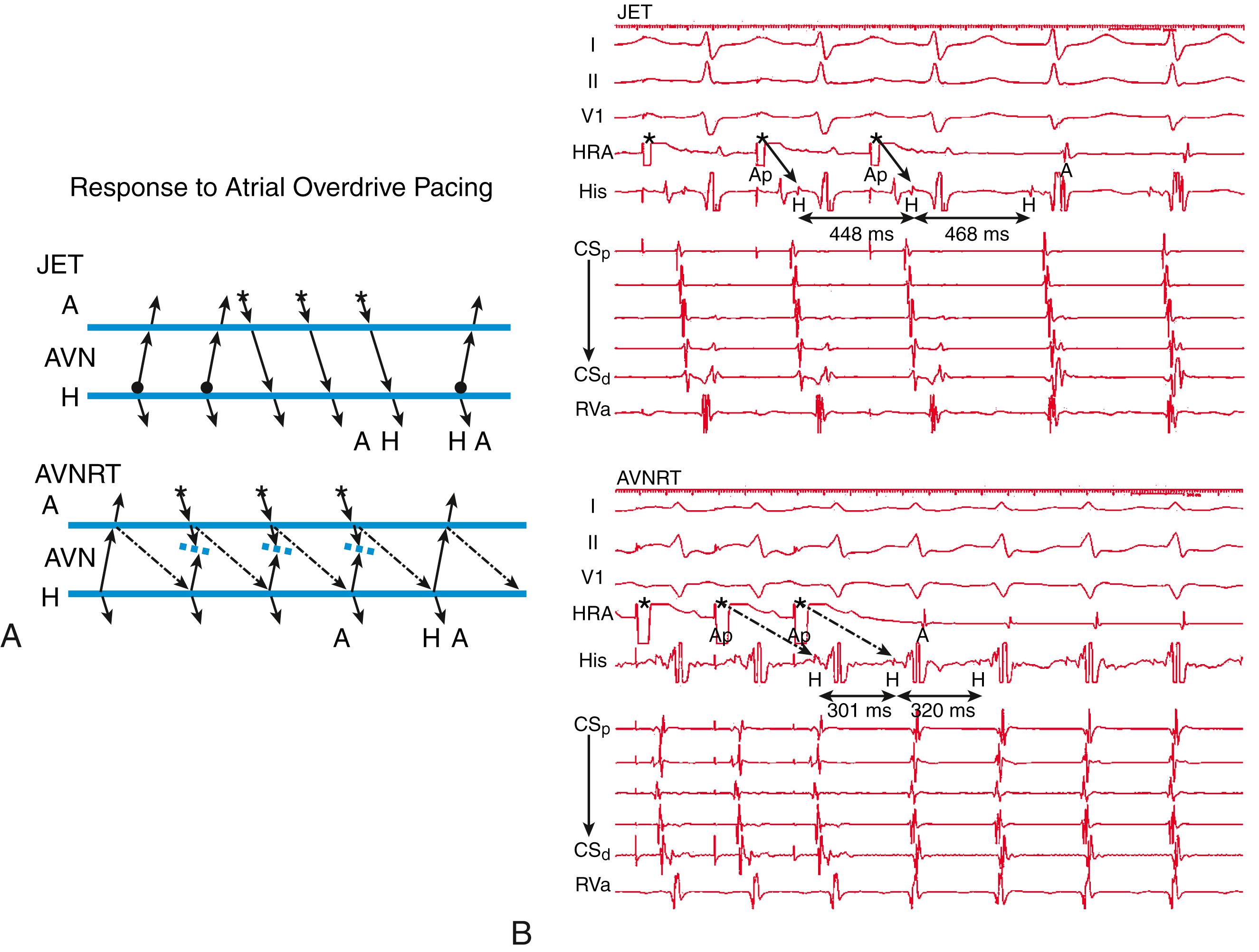Physical Address
304 North Cardinal St.
Dorchester Center, MA 02124
Junctional tachycardia, alternatively known as junctional ectopic tachycardia (JET), originates from the atrioventricular (AV) junction, which encompasses the AV node and His bundle. JET is rarely encountered, especially in the adult population, and its pathogenesis remains incompletely understood. Furthermore, its presentation can be variable, and the diagnosis and therapy can be challenging. This chapter focuses on the tachycardic forms of junctional arrhythmia, although escape rhythms that arise from the AV junction in the setting of severe bradycardia and AV block may also occur.
The surface electrocardiographic findings of JET can be variable depending on whether the tachycardia is paroxysmal or incessant and whether there is ventriculoatrial (VA) conduction during tachycardia. An incessant JET with a 1:1 VA conduction presents as a regular narrow QRS tachycardia with short RP interval and retrograde P waves, mimicking typical AV nodal reentrant tachycardia (AVNRT). In contrast, in paroxysmal JET without VA conduction, the electrocardiogram (ECG) will show an irregular narrow QRS tachycardia with intermittent sinus capture beats. During periods of frequent irregular junctional ectopy without obvious P waves or with variable distortion of the sinus P waves, the surface ECG can mimic the appearance of multifocal atrial tachycardia or atrial fibrillation. Finally, JET with bundle branch block can mimic ventricular tachycardia that involves the specialized conduction system, particularly if VA conduction is absent. Because of its relative rarity in the adult population, JET may not always be considered in the differential diagnosis and therefore may be underdiagnosed.
To differentiate JET from AVNRT based on the surface ECG, the pattern of tachycardia initiation can be informative, that is, whether there is critical prolongation of the PR interval on the initiating beat (which would suggest AVNRT). Bursts of short RP tachycardia without initiating premature atrial contractions (PACs) or PR prolongation suggest that JET is more likely. Finally, the complete absence of VA conduction also favors the diagnosis of JET because AVNRT with complete block of the upper common pathway is less likely.
The electrophysiologic hallmark of JET is the presence of a His bundle electrogram that precedes the QRS complex. The HV interval is either normal or prolonged (in the setting of infra-Hisian conduction system disease). A short HV interval in association with a narrow QRS complex (<35 ms) should prompt suspicion for fascicular tachycardia. The differentiation of JET with aberrant conduction from myocardial ventricular tachycardia is primarily based on the presence of a normal HV interval. When VA conduction is present, the differentiation of JET from atrial tachycardia can be based on the observation of the HH interval variability driving the A-A interval variability. Ventricular overdrive pacing yields a V-A-H-V response, also ruling out atrial tachycardia.
As indicated earlier, the most challenging differential diagnosis is between JET and AVNRT, as the two arrhythmias present with similar HV intervals recorded during tachycardia and sinus rhythm. Each arrhythmia may also be associated with VA block. Several maneuvers can help differentiate JET from AV nodal reentry, but these require the presence of VA conduction. Atrial overdrive pacing yields an A-H-H-A response in JET and an A-H-A response in AVNRT ( Fig. 73.1 ). In the case of JET, overdrive pacing advances His bundle activation to the pacing cycle length (A-H). JET resumes after the cessation of pacing, with the first return beat of the tachycardia characterized by an H-A sequence. Therefore the general response to atrial overdrive pacing in JET is A-H-H-A. In a typical slow-fast AVNRT, atrial entrainment proceeds via the slow pathway (same anterograde limb as the reentrant circuit); therefore the final entrained His has a long A-H interval and results in the immediate return of atrial activation via the retrograde fast pathway (A-H-A response). Alternatively, atrial overdrive pacing may terminate AVNRT by causing an anterograde block in the slow pathway and a block in the retrograde fast pathway. Another useful maneuver involves the introduction of PACs during tachycardia. A late-coupled PAC delivered during His refractoriness does not affect the continuation of JET because it does not reset the JET focus but can preexcite or delay the subsequent ventricular beat in AVNRT by engaging the anterograde slow AV nodal pathway ( Fig. 73.2A–B ). An early coupled PAC that captures the His bundle and ventricle advances JET for one cycle with subsequent continuation of the tachycardia, whereas an early PAC often terminates AVNRT because it anterogradely engages the fast pathway to advance His bundle activation, thus preventing retrograde activation of the fast pathway from propagation that emerges from the slow pathway (see Fig. 73.2C–D ). A similar response to PACs can also be demonstrated in the absence of a His bundle recording ( Fig. 73.3 ).



Become a Clinical Tree membership for Full access and enjoy Unlimited articles
If you are a member. Log in here